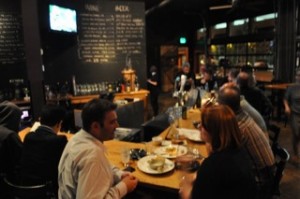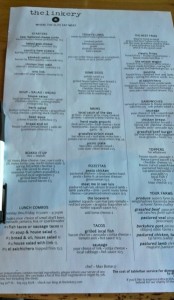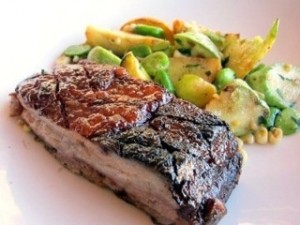I’m all about trying new restaurants and I try my hardest to stay away from the big chains. Chipotle and In-N-Out can be good eats, so I’ll leave those guys alone, but there is something about walking into a new restaurant and exploring their ambiance and menu. The experience is enhanced when you know that the food is prepared with passion, quality ingredients, and in full support of local farms. One afternoon, as I was searching for a restaurant option for dinner, I stumbled upon a restaurant in San Diego with a tag line “Where The Elite Eat Meat.” While I don’t consider myself part of the “elite”, the name intrigued me. The restaurant was displayed as a farm-to-table restaurant specializing in world class pastured meats, local produce, hand-made cuisine, local craft beers and local & world wines. Are you drooling yet?
If I am going to spend my hard earned money at a restaurant, I’d prefer to spend it at a place that serves quality food and gives back to the community. This place seemed to fit the bill, so I was off to explore The Linkery.
Their menu clearly displays the different farms that provide their produce and meat to the restaurant. It’s important to be able to understand the source of the food you are consuming, not just at home, but at restaurants. By knowing your farmer, you know how the animals were raised and how they were fed. For businesses, this can be important to be able to discuss any problems and ensure proper deliveries.
Farm to table restaurants have been hot in the news and were even mentioned in Amy’s Top 10 post. I wanted to write a post to provide you with some information regarding these types of restaurants, their trials and tribulations, and some fun facts that you may not have known so I interviewed the owner of The Linkery, Jay Porter, and his Executive Chef, Max Bonacci, to get the inside scoop!
The answers below are based off of a conversation between myself, Max, and Jay on December 26, 2011.
Starting a farm to table restaurant
Jay decided to create a farm to table style restaurant even though he had no previous restaurant experience. His passion for creating a restaurant featuring local, seasonal cuisine was the driving force for paving his way in the industry. He personally eats this way and wanted to share this style of eating with his family, friends, and the community. He grew up in San Diego, CA and said that there was only one farm to table restaurant available in the area when they opened in 2005. That restaurant closed in 2006, leaving The Linkery as the only farm to table restaurant at that time. The two restaurants shared ideas and learned from each other. In this type of business, owners seem to be more open to helping each other and sharing ideas, as there is still a need to spread the word about farm to table restaurants. Prior to opening his first restaurant, he met with distributors of meat and produce to further discuss the options and the overall concept. Jay then went on to create another farm to table Mexican restaurant and bar in San Diego called El Take It Easy, which opened its doors in 2010.
Menu creation and scheduling
The menu offers seasonal, local produce so the menu changes by season and availability. The executive chef, Max, tries to plan the menu on a weekly basis, but the menu can change each day depending on what they have left in the kitchen. He typically places orders on a daily basis. One very interesting fact that Max mentioned was that they try to use every piece of the produce and every part of the animal. They use the heart and liver for menu items and the tails and feet for stocks. The pieces of produce that they absolutely need to discard, they put in a compost bin to give back to the farms.
Max also makes visits to the farms and helps them out. This helps solidify the relationship the restaurant has with the farms, helps understand their processes, and helps the partners better understand their needs. It is definitely more than a business relationship. The restaurant tries to make it easier on the farmers by reworking the produce as it changes throughout the season. Produce that might be too large or small or too ripe can be repositioned as different components in the recipes.
The most popular recipes are the baked goat cheese, grass-fed burgers, fish tacos, and hand-made sausage links.
Farm to table trials and tribulations
If one of the first issues that comes to your mind about farm to table restaurants is the pricing, you are spot on! Charging an appropriate price that will get people in the door is a huge barrier to overcome. Jay noted that the food is of a premium quality, so pricing the product so that it still brings in customers, but allows for revenue is tricky.
Another interesting fact Jay mentioned was that in order to sell meat, it has to be slaughtered in a USDA plant. This isn’t a problem for processing plants that slaughter large numbers of animals, but pastured animals need to be taken to a USDA plant that takes independently raised animals. The closest one is about 8 hours away, so the restaurant has to buy meat from the central coast near the processing plant to allow for the processing.
But there’s always a reward
Jay was excited about the opportunity for himself and the community to be able to eat like this every day. The restaurant is open for lunch and dinner, so farm to table cuisine is an available option throughout the day and even on weekends. He takes pride in the fact that his restaurant serves about 80% of their produce from local farms. Other restaurants that claim to be supportive of local farms may only serve 1-2 locally produced items. This allows other restaurants to make more revenue and charge less for their products, but still make the “local” claim. One other rewarding part of this business is that his employees are very supportive of the community and the overall work environment is positive.
Cost and Revenue
This business is significantly different from a traditional restaurant. That being said, you cannot compare the cost and revenue of a farm to table restaurant with a traditional restaurant. It’s all about the quality of the ingredients. While The Linkery’s pricing structure is mid-priced, their products are premium. To help relieve some of the cost, their environment is more laid-back and is positioned in a less expensive location.
As far as profit and business success, Jay mentioned that it is pretty tough to earn a profit with this type of business, at least in the San Diego area. Because they sell a premium product and need to cater their pricing to the target market, all seven years that they have been in business have not been high revenue years. You can tell that Jay genuinely cares about serving his community and the business is not all about the money.
Advice for potential entrepreneurs
As mentioned in the question above, the restaurant’s location is vital in ensuring a profit. Jay stated that if he were to do it all over again, he would have opened the restaurant in a city with a bigger target market. Portland, Seattle, Chicago, and San Francisco are appropriate markets for this type of business as there is more of a demand. These cities have populations that understand food systems and may be willing to pay a premium price for a premium product. Educating the public about this type of business is a difficult job. Customers need to understand the health benefits and quality of local/pastured products.
Educating the San Diego area about food systems and the quality of their product is something The Linkery is working on. This would be an essential piece to consider for something looking to start this type of business.
Creative marketing, having an active blog, using media outlets (Facebook, Twitter), and mailing lists are also important pieces to bring in customers.
This restaurant was given national props from Gourmet magazine, Imbibe magazine, and Bon Appetit magazine, which encourages customers to visit. Jay said that many of the customers have previously lived in areas that are knowledgeable about local and pastured foods. He’s had people come directly from the airport with their luggage in hand to experience this type of cuisine!
Saving the best for last: A recipe from The Linkery
Jay said something that really resonated with me when I asked him for a recipe. He was asked a similar question by a national magazine. They were wondering how he makes the coleslaw taste so good. His answer? First, find a quality chicken to provide quality eggs. Then find a local farmer to provide you with cabbage and the other produce. It is all about the quality of the ingredients, not an extensive recipe.
Chicken Liver Pâté
Ingredients:
1 whole white onion, diced
5 cloves of garlic, chopped
10 chicken livers, rinsed and salted overnight
1/8 t. ground nutmeg
1/8 t. ground clove
½ T. salt
¼ t. black pepper
Instructions:
Sauté onions, garlic, and chicken livers. Add seasoning and blend in a food processor with 2 t. olive oil until desired consistency. If you have one available, push pâté through a tamis (strainer) for smoother consistency.
Take Away Message
I highly encourage you to search for farm to table restaurants in your local area. While the prices may be higher than your typical hot spot, you can take pride is serving your community and local farms. The food is not only better for you, but the taste is infinitely better than the corn raised and nutrient depleted product you’ll be getting from the standard restaurant. For those of you looking to make a difference and help support the Paleo lifestyle and local farmers, this could be a great area of opportunity for you. Restaurants need passionate people to help educate the public about their offerings and the health benefits associated with locally grown, grass-fed, and pastured products. If you know of any other restaurants like this in your area, please feel free to share for others to check out!
A special thanks to Jay and Max for taking the time out of their busy schedules for the interview.






Yay on the chicken liver recipe! I just put 60 lbs of it in my freezer so i have been looking for some things to do with it. I made a butternut squash curry dish with it that was nice.
The Linkery is a great place. I had an absolutely amazing fresh salad there along with delicious links. So true about the recipes – first find a quality source. The Linkery sources much of their produce from Suzie’s Farm in Imperial Beach, which is also my CSA. You simply can’t beat the quality of the finished product when you start with the best, freshest ingredients. It will cost you more, and you probably won’t eat as much because of the cost, but you will savor every bite. I can’t think of a time that I ever savored a bite of fast food.
Suzie’s Farm is great! I use them for my CSA as well 🙂 Have you tried El Take It Easy? There’s something to say about the people who go into this type of business. It’s not about the money to them, it’s all about community and providing healthy choices.
Thanks for this Stephanie, I will be coming down to San Diego one of these weekends to go eat here, I am super excited. Good looking out.
Excellent – you’ll love it! If you have any free time when you’re here, let me know!
I absolutely LOVE my local Farm to Table restaurant. It is my “go to” these days for special occasions (my budget can’t handle me eating there regularly!!)
My local place is Station 220 in Bloomington IL. Amazing stuff there!
Thanks for sharing for the IL folks!
Hey, I am from Normal. Was just going to state on the Station 220. It is absolutely wonderful food. I also wish I could afford to go there more.
I think we are priviledged to have someone dedicated to bring food like that to Central, IL because we don’t get to experience great food often.
Thanks for the heads up on Station 220! I travel to Bloomington quite frequently for work and have heard it’s good, but never have been there. I will make that a destination for my next trip!
Thanks again!
Coppa in Boston is close to farm to table
If you’re ever in Athens, GA please check out Farm 255.
Specializing in Farm-to-Table cuisines in the state’s main college town.
(Disclosure: I don’t work there, I just love the burgers!)
http://www.farm255.com/
If you’re in St. Louis, MO, check out Schlafy Bottleworks in the Maplewood area. I’m not sure if they are 100% farm to table, but they have to be pretty darn close! I know that they get meat and such from local farms. They even have a garden located right outside the restaurant that they pull veggies from- then fertilize with waste from their resurant.
And the food is pretty gosh darn good!
St. Louis has a couple of other good restaurants that are pretty much farm to table. One is in the Soulard area, “Market Grill in Soulard,” http://marketgrillsoulard.com/. The other is “Farmhaus Restaurant” in South City, http://farmhausrestaurant.com/. Both pride themselves on getting fresh produce and grassfed meat from area farmers. I have eaten at Market Grill and the food was excellent!
I hope the concept takes off here in Australia. My concern is that lately the hype is “dude food” (American-style burgers, hot dogs, nachos, etc.), American-style steakhouses, etc.
Great find. This place is the real deal. You don’t have to do much Googling on their farms to see that it’s legit.
I’d love to see a piece on the difference between places that serve livestock that was fed on its ancestral diet and those selling grain fed livestock under the banner of “farm to table, local, sustainable, organic, etc.” People would be interested to know some of the nutritional distinctions.
Here in Chicago, we have a lot of farm to table restaurants but you have to do some digging to find out how legit the meat really is. A lot of “farm to table” places in Chicago serve Slagle Farms beef. It’s grain fed. A lot of places serve Gunthorp Farms pork and chicken. The animals are pastured but fed grain and whatever else they can root out in the pasture including mulberries and acorns. So the animals have a better life than CAFO animals but I wonder if the meat is really that much better from a nutritional standpoint. A lot of crappy vegetables and less than optimum livestock is raised on “farms” but if you don’t dig in and investigate the farms, you may just be paying “farm to table” prices for food that is of equal nutritional value as the stuff you can buy at the supermarket. Just because the name of the farm is on the menu doesn’t mean it’s healthier for you.
If it wasn’t for Robb Wolf and the paleo community I probably wouldn’t even investigate and geek out on farmers and feeds. Keep it coming.
Thanks for the run-down on The Linkery. It’s in my ‘hood and I drive by it nearly every day and keep kicking myself for not trying it out.
Regarding the quote about opening a Linkery-style restaurant in Chicago or other large town, instead of San Diego, I think they’d find similar challenges on bringing in the clientele and/or raising prices. While it’s true that larger cities have a larger target audience, there is much more competition, and even very good restaurants often find themselves closing up shop (check out Metromix Chicago at http://bit.ly/oIvTIq for 2011 closings). It’s a challenging world out there for restaurants and “farm-to-table” isn’t enough to bring in the crowds.
That said, best of luck to The Linkery! They’re part of the resurgence of the North Park area in San Diego for good restaurants, bars, and shopping.
If you are in San Diego, you’ve got to support this place. Not just because it’s farm to table but because it’s awesome. We went in twice while on vacation last year and had several small plates. I never thought I’d like octopus but they had bacon wrapped grilled octopus in lettuce wraps that was amazing. We are already planning a return visit if we can get there for vacation this year.
My husband and I had gone to The Linkery back when we were just emerging from our vegetarian states. The whole concept of a sausage/meat-focused restaurant grossed us out. We decided to give it another shot last night (with new Paleo eyes), and the food was delicious. We each got two sausage links and kraut. We’ll be going back!
Great in-depth article. Check out the video I just did with Jay and Max: http://eepurl.com/icJiU
Also, I would avoid In-n-Out. Their meat comes from the Harris Ranch feedlot AKA Cowschwitz. http://politicsoftheplate.com/?p=1112
Wow, nice video addition! Thanks for sharing that visual! I’m looking forward to your upcoming interviews.
“other restaurants that claim to support local farms may only serve 1-2 locally produced items”. This can be true but should not be a blanket statement. At The Red Door we not only support local with local fish and veggies but we grow our own in our own intensively farmed 1/2 acre garden. Max is right, local meat is a problem because of the need for USDA processing. We are working with San Diego Meat to feature their Julian Beef when it becomes available. CUDOS to Jay for starting the local, farm to table movement in San Diego! He was definitely a pioneer.
Exactly why I stated “may.” I’d love to give every restaurant that makes that claim credit, but there are some that truly only serve one or two ingredient. I’m happy to hear about The Red Door’s work to support their local farmers and I think it’s great you grown your own! Thanks for being a part of this movement!
Thats great! We often visit farm to table restaurants because you know that the chef is really involved in the ingredients and what is being put on the table.
We also got to see another side of the coin last summer when the wife was managing a local farm stand. She got to meet all sorts of restaurant owners and chefs who were stocking up there shelves. It was very interesting to see the relationship between chef and farmers first hand. The chefs were very interesting in quality and it gave the farmer a sure sale so that they could have some security.
Thanks!
I happen to live less than 2 miles from the Linkery; it’s one of my favorite places to eat 🙂 Delicious food and very nice staff. Highly recommended! Only drawback, no gluten free beer…if you’re into that sort of thing.